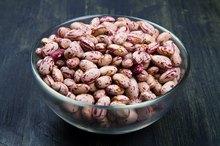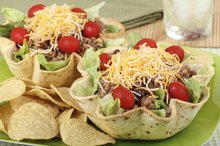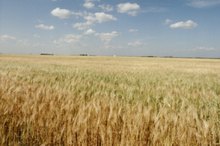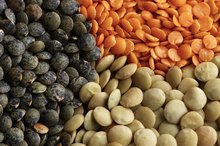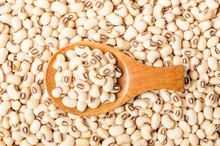What does fact checked mean?
At Healthfully, we strive to deliver objective content that is accurate and up-to-date. Our team periodically reviews articles in order to ensure content quality. The sources cited below consist of evidence from peer-reviewed journals, prominent medical organizations, academic associations, and government data.
- Centers for Disease Control and Prevention: Protein
- MayoClinic.com: Dietary fiber: Essential for a Healthy Diet
The information contained on this site is for informational purposes only, and should not be used as a substitute for the advice of a professional health care provider. Please check with the appropriate physician regarding health questions and concerns. Although we strive to deliver accurate and up-to-date information, no guarantee to that effect is made.
Legumes and grains are a good source of protein, particularly in a vegetarian diet. Barley is a grain that is also a good source of fiber, and lentils belong to the legume family, along with beans. Whether you are following a vegetarian diet and need complete sources of protein, or are replacing meat in a few meals a week, dishes that include barley and lentils are a tasty choice.
Protein
Protein is important for building muscle, but beyond that it plays a role in maintaining all of the organs and tissues in the human body. Amino acids make up protein, but many are not made by the body and are only found in food sources. These are called essential amino acids, and according to the Centers for Disease Control and Prevention, sources of protein are classified by the amount of amino acids they contain. Meat provides all the essential amino acids needed by the body and is considered a source of complete protein. Plant sources of protein, such as barley and lentils, do not contain all of the essential amino acids, but when they are combined they do add up to a complete protein source.
- Protein is important for building muscle, but beyond that it plays a role in maintaining all of the organs and tissues in the human body.
- Plant sources of protein, such as barley and lentils, do not contain all of the essential amino acids, but when they are combined they do add up to a complete protein source.
Strategy
Are Pinto Beans a Complete Protein?
Learn More
Barley and lentils are sources of incomplete protein because by themselves they do not provide all of the essential amino acids you need. When you combine them they are called complementary proteins because together they provide all of the essential amino acids. Eating barley and lentils in the same dish or during the same meal is an easy way to get complete protein, but you do not have to eat them together. If you eat incomplete proteins at separate times during the day your body will still combine them into a complete protein source, so you can have barley for lunch and lentils for dinner and get all the protein you need.
- Barley and lentils are sources of incomplete protein because by themselves they do not provide all of the essential amino acids you need.
- If you eat incomplete proteins at separate times during the day your body will still combine them into a complete protein source, so you can have barley for lunch and lentils for dinner and get all the protein you need.
Nutrients
A cup of cooked barley contains 3.5 grams of protein, 193 calories and less than 1 gram of fat. A 1/4-cup serving of cooked lentils provides 8 grams of protein, 130 calories and half of a gram of fat. If you eat 1/2 cup of barley with 1/2 cup of lentils you will get nearly 18 grams of complete protein. Barley and lentils are also excellent sources of fiber, which MayoClinic.com points out is important for healthy bowels and may help lower cholesterol levels, maintain blood sugar levels and help you lose weight 1.
- A cup of cooked barley contains 3.5 grams of protein, 193 calories and less than 1 gram of fat.
- If you eat 1/2 cup of barley with 1/2 cup of lentils you will get nearly 18 grams of complete protein.
Recipes
Does the Taco Shell of a Taco Salad Have Gluten?
Learn More
While you can eat barley and lentils separately at different meals, combining them boosts nutrients and flavor in a dish. Soups and stews with barley and lentils are hearty. Use plenty of vegetables, such as carrots, onions and sweet potatoes, when creating your dishes to increase the nutrient levels even more. Combine cooked barley and lentils to make vegetarian burgers. Cook and cool barley and lentils and combine with an olive oil vinaigrette and raw vegetables for a luncheon salad.
- While you can eat barley and lentils separately at different meals, combining them boosts nutrients and flavor in a dish.
- Use plenty of vegetables, such as carrots, onions and sweet potatoes, when creating your dishes to increase the nutrient levels even more.
Related Articles
References
- MayoClinic.com: Dietary fiber: Essential for a Healthy Diet
- Lentils, dry, cooked, fat not added in cooking. USDA FoodData Central. Updated April 1, 2019.
- Abeysekara S, Chilibeck PD, Vatanparast H, Zello GA. A pulse-based diet is effective for reducing total and LDL-cholesterol in older adults. Br J Nutr. 2012;108 Suppl 1:S103-10. doi:10.1017/s0007114512000748
- Ganesan K, Xu B. Polyphenol-Rich Lentils and Their Health Promoting Effects. Int J Mol Sci. 2017;18(11):2390. Published 2017 Nov 10. doi:10.3390/ijms18112390
- Polak R, Phillips EM, Campbell A. Legumes: Health Benefits and Culinary Approaches to Increase Intake. Clin Diabetes. 2015;33(4):198–205. doi:10.2337/diaclin.33.4.198
- Ha V, Sievenpiper J, de Souza R et al. Effect of dietary pulse intake on established therapeutic lipid targets for cardiovascular risk reduction: a systematic review and meta-analysis of randomized controlled trials. Can Med Assoc J. 2014;186(8):E252-E262. doi:10.1503/cmaj.131727
- Sievenpiper JL, Kendall CW, Esfahani A, et al. Effect of non-oil-seed pulses on glycaemic control: a systematic review and meta-analysis of randomised controlled experimental trials in people with and without diabetes. Diabetologia. 2009;52(8):1479-95. doi:10.1007/s00125-009-1395-7
- Rebello CJ, Greenway FL, Finley JW. A review of the nutritional value of legumes and their effects on obesity and its related co-morbidities. Obes Rev. 2014;15(5):392-407. doi:10.1111/obr.12144
- Variety of lentil proteins makes recommendations on avoidance difficult. American Academy of Allergy, Asthma, and Immunology. Published July 24, 2015.
- Legumes (Including Pulses). Anaphylaxis Campaign. Published March 2019.
- Jensen K, Ni Y, Panagiotou G, Kouskoumvekaki I. Developing a molecular roadmap of drug-food interactions. PLoS Comput Biol. 2015;11(2):e1004048. Published 2015 Feb 10. doi:10.1371/journal.pcbi.1004048
- Ndidi US, Ndidi CU, Olagunju A, Muhammad A, Billy FG, Okpe O. Proximate, Antinutrients and Mineral Composition of Raw and Processed (Boiled and Roasted) Sphenostylis stenocarpa Seeds from Southern Kaduna, Northwest Nigeria. ISRN Nutr. 2014;2014:280837. Published 2014 Mar 16. doi:10.1155/2014/280837
- Anti-nutritional Factors. U.S. National Library of Medicine.
- Before You Toss Food, Wait. Check It Out! U.S. Department of Agriculture.
Writer Bio
Since 1997, Maria Christensen has written about business, history, food, culture and travel for diverse publications. She ran her own business writing employee handbooks and business process manuals for small businesses, authored a guidebook to Seattle, and works as an accountant for a software company. Christensen studied communications at the University of Washington and history at Armstrong Atlantic State University.
